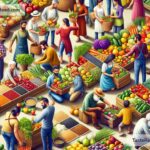The Impact of Food Vulnerability on Nutrition
Food is more than just something we eat. It’s the fuel our bodies need to grow, stay healthy, and have energy. But what happens when people don’t have enough access to healthy food? This is called food vulnerability, and it affects millions of people worldwide. Food vulnerability happens when someone doesn’t have steady access to affordable, nutritious food. For many people, this means skipping meals, eating less healthy options, or suffering from malnutrition. In this blog, we’ll explore how food vulnerability impacts nutrition and health in simple terms.
What is Food Vulnerability?
Food vulnerability refers to situations where people struggle to access the food they need to live healthy lives. Limited access to food can happen for many reasons, such as poverty, natural disasters, war, or gaps in food systems. It can also affect specific groups like children, older adults, and people living in poor communities.
If you think about how you get food every day, it might seem simple—shopping at the store, cooking meals, or ordering from a restaurant. But for people experiencing food vulnerability, an empty fridge or wallet can mean tough choices. Should you buy cheaper processed foods? Should you pay bills or buy vegetables? These situations are common for vulnerable families and have big consequences on their nutrition.
Nutrition and Food: A Close Connection
Good nutrition comes from eating balanced meals filled with vitamins, minerals, and other nutrients. Fresh fruits, vegetables, lean proteins, and whole grains play an important role in keeping our bodies strong. When people don’t have access to these foods, their nutrition suffers, and so does their health.
For example, when fresh food isn’t available, people might turn to high-calorie processed foods like chips, instant noodles, or sugary snacks. These foods might feel filling, but they often lack nutrients that your body needs. Over time, not getting enough nutrients can lead to serious health problems.
The Effects of Poor Nutrition
Food vulnerability leads to poor nutrition. This happens when people don’t eat enough healthy food to get the vitamins, proteins, and nutrients their bodies need. Poor nutrition can cause short-term and long-term health effects:
-
Lower Energy Levels
When you don’t eat well, your body doesn’t have enough energy. This can make people feel tired, unable to concentrate, and less productive at school, work, or other daily tasks. -
Weaker Immune System
Nutritious foods help keep your immune system strong so that your body can fight off illnesses. Poor nutrition makes it harder for your body to fight infections, leading to more frequent sickness. -
Delayed Growth in Children
Children need nutritious foods to grow properly. Without it, they may suffer from stunted growth, which can affect their height, weight, and mental development. -
Higher Risk of Diseases
Long-term poor nutrition can lead to health issues like diabetes, heart disease, and obesity. Some people experience both malnutrition (not getting enough nutrients) and obesity (too many unhealthy calories) at the same time because their diets rely on processed foods. -
Mental Health Issues
Food and nutrition don’t just affect the body—they also impact the mind. Poor nutrition can lead to mood swings, anxiety, or even depression.
Who is Most Affected by Food Vulnerability?
Food vulnerability hits hardest in groups that already face challenges. Children are one of the most vulnerable groups. Without healthy meals each day, children can struggle in school, have less energy for play, and experience weaker growth.
Older adults also face food vulnerability, especially those who live in poverty or need special diets. For example, an older person needing low-sodium meals for heart health may not afford those options.
Single parents, low-income workers, and people without stable housing also face higher risks of food vulnerability. Additionally, some communities experience systemic barriers, like lack of grocery stores nearby or higher food costs, that make accessing good nutrition harder.
Ways to Fight Food Vulnerability
Addressing food vulnerability is important for healthier people and communities. Here are ways individuals and organizations are working to make a difference:
-
Food Assistance Programs
Governments and charities provide food banks, free school lunches, and meal delivery to help people in need. These programs ensure that vulnerable families have access to food. -
Education
Teaching people how to cook affordable and healthy meals can improve nutrition. Simple lessons about meal planning and reading food labels can go a long way. -
Community Efforts
Local organizations often work together to establish farmers’ markets, community gardens, and food-sharing initiatives. These efforts make nutritious food more accessible. -
Improving Food Systems
A better global food system can reduce vulnerability. This includes fair prices for farmers, reducing food waste, and improving supply chains to make fresh food available everywhere. -
Individual Action
Every person can help fight food vulnerability. You can donate to food banks, volunteer in your community, or support policies that make food more affordable for everyone.
Final Thoughts
Food vulnerability is not just an issue of hunger—it impacts the nutrition and overall health of millions of people. Without access to nutritious foods, people face challenges that affect their growth, energy, immune system, and mental health. This problem requires action from governments, communities, and individuals alike.
Together, we can make nutritious food a right, not a privilege, for every person. A healthier world starts with fighting food vulnerability and ensuring everyone has access to the food they need to thrive.


